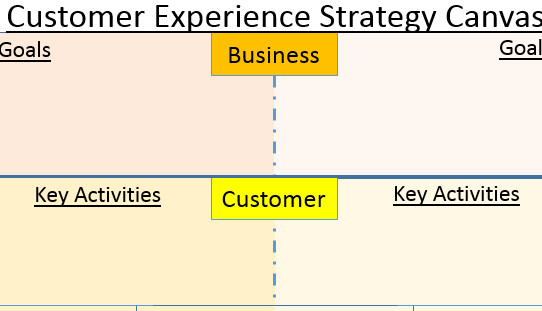
Introducing the Customer Experience Strategy Canvas V0.1
Author update (April 2017): A newly updated version of the Canvas is now available. Further details can be found here.
Author update (May 2016): If you want more detailed help in implementing the Canvas than what is detailed below, a comprehensive guide to using the Canvas to develop a robust Customer Experience strategy is now available for purchase on Flevy.com.
About a month ago I had a conversation with a Customer Experience Director I had just met at a corporate lunch. She asked me if I had a good one-page template for helping define and document a company’s customer experience strategy, as she couldn't find one. My initial response was “Yes, of course I do” as I use a number of good frameworks myself to help my clients define their strategy.
However, when I got back to my office and reviewed these frameworks I realised that whilst they helped define various components needed in a strategy they weren't actually great for helping a company document its customer experience strategy in a way that made sense and was clear to everyone.
I did some more research online and realised that there wasn't actually anything I could find that fulfilled the need to define a thorough customer experience strategy easily and in an understandable way.
I thus decided I needed to create my own way to capture any company's customer experience strategy in one page and thus the Customer Experience Strategy Canvas V0.1 was born*!
See below for a detailed explanation of the Canvas, and click here for a downloadable version including a guide to completion and an example.
Aim Of The Canvas
The aim of this canvas is to help any company define its customer experience strategy in a way that is thorough but also easy to understand and share.
What Are Its Parts
The Canvas consists of a number of different sections, with multiple blocks in each area.
1. The Canvas is split into Pre-Sales on the left of the canvas, and Post-Sales on the right of the Canvas. In some cases similar blocks appear on each side, and in some cases they are different.
2. At the centre of the Canvas is the Customer section. The blocks in this section help define the experience your customer is after, including
- Who your customer is
- Their Needs (pre and post-sales)
- Key Activities - Key Activities undertaken by the customer (once again pre and post sales)
- Interaction Preferences (how they like to deal with your company)
3. The outside of the canvas consists of the Business section. In this section, you define how the business provides the customer experience through the following sections
- Goals – Your company goals in relation to customer experience (split pre and post sales)
- Culture – The culture applied in the company to reflect and promote the desired customer experience
- Key Activities - Key customer focussed activities undertaken by the business (split pre and post sales)
- Channels – The pre and post sales customer channels that the business will support (pre and post sales)
- Metrics – The key customer experience metrics for the company (pre and post sales)
- Sales Model – The principles you will incorporate into the experience of selling to your customers
- Service Model – The principles behind the way you will address customer questions, issues and complaints
- Awareness / Engagement Plan – The way you will engage and make customers aware of your business and product / services (pre-sales)
- Retention Plan – The customer experience you will put in place to retain customers and their loyalty
How Do You Complete It?
The best (and really only) way to complete the Canvas is to start at the centre and move outwards. It is important to define the customer view of the world first, and then define how the business will deliver that experience. The diagram below shows the order of completion for the sections in the Canvas.
An Example
To help illustrate how to use the Canvas below is a completed example for a fictional company, FurnCo, and company that sells furniture through their website and some retail outlets. Hopefully this gives you some inspiration in using the Canvas for yourself.
What's Next?
This is the first version of the Canvas and I plan to improve it based on feedback and usage in the wild as time goes along. Any feedback you may have in how it could be improved would be greatly appreciated.
* - In building this Canvas I took inspiration from a number of other Canvas and specifically the Lean Canvas created by Ash Maurya along with the Business Model Canvas created by Alex Osterwalder. There are also a number of other easy to use Canvas available online depending on your specific needs.
This article was first posted on the CustCore blog
If you like this post you may enjoy reading some of my other recent articles including



Customer Experience | Process Optimisation |Business Improvement | Operations Management
7yFor those who found the initial version of the Canvas useful, I have published an updated version at https://www.linkedin.com/pulse/customer-experience-strategy-canvas-v20-shane-goldberg
Helping Businesses Align & Grow Around Their Customers Perspective
8yThis is a great tool Shane Goldberg. Will definitely put it to use and give you feedback as well. It really does capture the strategic components of a customer experience strategy on one page. Would be interesting to see how practitioners have been able to use as an effective communication and employee engagement tool as well
Bringing buyers and sellers together with story
8yThanks Shane, useful post
Customer Experience | Process Optimisation |Business Improvement | Operations Management
8yAmy Clark Thanks for the comment. Customer Journey Mapping is a really useful tool and critical in translating a strategy into reality. That article is good as are many others which detail the benefits of journey mapping.